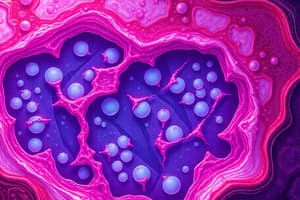Podcast
Questions and Answers
Which tissue type is primarily responsible for transmitting electrical signals throughout the body?
Which tissue type is primarily responsible for transmitting electrical signals throughout the body?
- Nervous tissue (correct)
- Connective tissue
- Epithelial tissue
- Muscle tissue
During a stressful situation, which division of the peripheral nervous system is primarily activated?
During a stressful situation, which division of the peripheral nervous system is primarily activated?
- Enteric division
- Somatic division
- Sympathetic division (correct)
- Parasympathetic division
Which of the following brain structures directly links the nervous system to the endocrine system by controlling the pituitary gland?
Which of the following brain structures directly links the nervous system to the endocrine system by controlling the pituitary gland?
- Cerebellum
- Amygdala
- Medulla Oblongata
- Hypothalamus (correct)
After a carbohydrate-rich meal, which hormone is primarily responsible for decreasing blood sugar levels?
After a carbohydrate-rich meal, which hormone is primarily responsible for decreasing blood sugar levels?
Which type of feedback mechanism is responsible for maintaining a stable body temperature by initiating cooling mechanisms when the body gets too hot?
Which type of feedback mechanism is responsible for maintaining a stable body temperature by initiating cooling mechanisms when the body gets too hot?
Smooth muscle is found in which of the following locations and what is its defining characteristic?
Smooth muscle is found in which of the following locations and what is its defining characteristic?
Which neurotransmitter is most closely associated with the regulation of mood, sleep, and appetite?
Which neurotransmitter is most closely associated with the regulation of mood, sleep, and appetite?
During childbirth, the release of oxytocin stimulates uterine contractions, which in turn triggers the release of more oxytocin. What type of feedback mechanism does this represent?
During childbirth, the release of oxytocin stimulates uterine contractions, which in turn triggers the release of more oxytocin. What type of feedback mechanism does this represent?
Flashcards
What are Tissues?
What are Tissues?
Groups of similar cells performing specific functions.
Epithelial Tissue
Epithelial Tissue
Covers, lines, protects, absorbs, and secretes; e.g., intestinal lining.
Connective Tissue
Connective Tissue
Supports, binds, and protects the body; includes bone, blood, and fat.
Muscle Tissue
Muscle Tissue
Signup and view all the flashcards
Nervous Tissue
Nervous Tissue
Signup and view all the flashcards
Nervous System
Nervous System
Signup and view all the flashcards
Medulla Oblongata
Medulla Oblongata
Signup and view all the flashcards
Negative Feedback
Negative Feedback
Signup and view all the flashcards
Study Notes
- Tissues are groups of similar cells performing specific functions.
Epithelial Tissue
- Covers the body, lines organs/cavities
- Functions include protection, absorption, and secretion
- Intestinal lining is an example
Connective Tissue
- Supports, binds, and protects various body parts
- Includes bone, blood, adipose tissue (fat), and cartilage
Muscle Tissue
- Facilitates movement through contraction
- Three types: skeletal, cardiac, and smooth
Skeletal Muscle
- Voluntary
- Striated
Cardiac Muscle
- Found in the heart
- Involuntary
- Striated
Smooth Muscle
- Involuntary
- Lacks striations
- Located in the digestive tract and blood vessels
Nervous Tissue
- Processes and transmits information
- Made of neurons and glial cells
Neurons
- Send signals via dendrites and axons
Glial Cells
- Support, nourish, and protect neurons
Nervous System
- Coordinates body functions through electrical signals.
Central Nervous System (CNS)
- Consists of the brain and spinal cord
Peripheral Nervous System (PNS)
- Comprises nerves outside the CNS
Sympathetic Division
- Triggers the "fight or flight" response
Parasympathetic Division
- Controls "rest and digest" functions
Key Brain Structures
Hypothalamus
- Regulates hunger, thirst and temperature
- It links the nervous and endocrine systems
Amygdala
- Controls emotions
- Key emotions are fear and aggression
Medulla Oblongata
- Regulates basic functions
- Key examples are breathing and heart rate
Pituitary Gland
- Known as the "master gland"
- Regulates hormones for growth, reproduction, and metabolism
Neurotransmitters
- Chemical messengers in the nervous system
Dopamine
- Influences motivation, pleasure, and motor function
Serotonin
- Affects mood, hunger, and sleep
Endorphins
- Serve as natural painkillers and induce pleasure
Cortisol
- Functions as a stress hormone
Endocrine System
- Regulates body functions through hormones released into the bloodstream.
- The hypothalamus controls the endocrine system via the pituitary gland
Adrenal Glands
- Located on the kidneys
- Release hormones for stress response
Adrenal Cortex
- Manages long-term stress
- Releases cortisol, mineralocorticoids, and glucocorticoids
Adrenal Medulla
- Handles short-term stress
- Secretes epinephrine and norepinephrine
Pancreas
- Regulates blood sugar
Insulin
- Lowers blood sugar by storing glucose
Glucagon
- Raises blood sugar by breaking down glycogen
Liver
- Stores and releases glucose as needed
Oxytocin
- Stimulates contractions during childbirth and milk ejection
EPO (erythropoietin)
- Increases red blood cell production
Homeostasis & Feedback Mechanisms
Negative Feedback
- Reduces the original stimulus to maintain balance
- Insulin lowering blood sugar is an example
Positive Feedback
- Amplifies the original stimulus
- Example: oxytocin during childbirth
Regulation & Control
Nervous System
- Employs fast, electrical signals to specific targets
Endocrine System
- Uses slower, hormone signals with widespread effects
Studying That Suits You
Use AI to generate personalized quizzes and flashcards to suit your learning preferences.
Description
Explore animal tissues: epithelial for covering and secretion, connective for support, muscle for movement (skeletal, cardiac, smooth), and nervous for information transmission via neurons and glial cells. Understand their structures, functions, and locations within the body.




